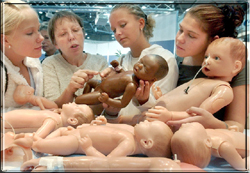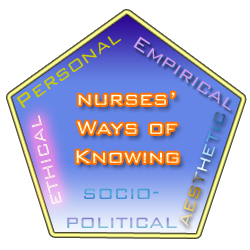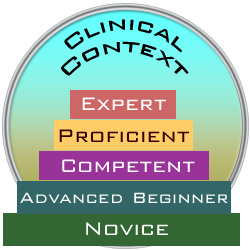|
|
Culture Becoming: Nursing Education
 Like many other disciplinary cultures, nursing education has undergone a profound metamorphosis in the past two decades. Traditionally, nursing students were educated using an apprenticeship model of instruction framed within a distinct biomedical, positivist, behaviourally-focused paradigm. As nursing education moved from an exclusive clinical setting into colleges and later university settings, a shift towards the humanities and a more holistic paradigm was adopted, though nursing education and culture still occurred within a deductive modernist framework. Remnants of this still exist, coupled with humanistic, critical social theory, and feminist-postcolonial lens to ultimately cultivate neophyte nurses who are empowered, engage in dialogue, reflection and praxis, and who provide care that is distinctly phenomenological, client-focused and salient to the individual client's health needs and situation. Like many other disciplinary cultures, nursing education has undergone a profound metamorphosis in the past two decades. Traditionally, nursing students were educated using an apprenticeship model of instruction framed within a distinct biomedical, positivist, behaviourally-focused paradigm. As nursing education moved from an exclusive clinical setting into colleges and later university settings, a shift towards the humanities and a more holistic paradigm was adopted, though nursing education and culture still occurred within a deductive modernist framework. Remnants of this still exist, coupled with humanistic, critical social theory, and feminist-postcolonial lens to ultimately cultivate neophyte nurses who are empowered, engage in dialogue, reflection and praxis, and who provide care that is distinctly phenomenological, client-focused and salient to the individual client's health needs and situation.
Yet, the culture taught in nursing schools, with professional ideals of autonomy, empowerment, and reflective practice clashes with the “highly bureaucratic institutions in the health care system” (Clare, 1993, p. 1034). As students gain experience within the clinical milieu, they often experience a discrepancy between the ideal culture taught in school, and the manifest culture experienced within the hospital and community care settings. “There is a cultural crossroads created when two or more cultures come into contact” (Blackford, 2003, p. 239) but this crossroads can become an area of contention, disillusion and distress, rather than an intersection of compatibility and congruence: sometimes to the point of “culture shock”.
Nursing education begins with a concrete focus on understanding the workings of the human body and mind, and how these are influenced by various health challenges. Three themes of conceptual structure in nursing are incorporated with this focus:
- principles and laws related to life processes, well-being, and optimal functioning of humans
- patterning of human behaviour in interaction with the environment in critical life situations
- processes by which positive changes in health status are affected (Hayne, 1992).
 All Western nursing education now occurs within degree-granting configurations, where nursing students gain practical and theoretical experience in working with clients on various specialty units as well as in the community, including in-home care, clinic-based work, public schools and other community service areas. Students are enculturated to influence change, conduct both qualitative and quantitative research, to inquire in phenomenological ways, to advocate, to empower, and to develop empathy and respect for the unique lives, beings, and saliency of each unique client and their supportive families and circles. All Western nursing education now occurs within degree-granting configurations, where nursing students gain practical and theoretical experience in working with clients on various specialty units as well as in the community, including in-home care, clinic-based work, public schools and other community service areas. Students are enculturated to influence change, conduct both qualitative and quantitative research, to inquire in phenomenological ways, to advocate, to empower, and to develop empathy and respect for the unique lives, beings, and saliency of each unique client and their supportive families and circles.
Ways of Knowing
 Nursing students are taught several different ways of knowing, including personal knowing, in order to holistically plan and provide comprehensive client care. “Personal knowing is the most problematic and difficult pattern to master and teach. It is the ability to see an event from the perspective of another and recognizing the other as a subject rather than as an object. Personal knowing is the discovery of self and others, which is arrived at through reflection, synthesis of perceptions, and connecting with what is known. It is captured through retrospective accounting of an interaction. The creative dimension of personal knowing is the process in which one becomes genuine, authentic, real and more whole” (Jacobs, 1998, p. 25). Personal knowing is engrained through therapeutic reciprocity or the therapeutic use of self. This application of self promotes integrity and wholeness in personal encounters with clients and with other student and practicing nurses. By creatively blending personal knowing with empirical, aesthetic, ethical and socio-political knowledge (Carper, 1987), student nurses learn to perform within a therapeutic caring culture that is holistic and salient to the client's health condition and recovery. This “...shows patients and their families that the nurse understands their world and can interpret some of their decisions and experiences in an enlightening context that will facilitate their growth and understanding of the difficult situation. Personal knowing is central to nursing since illness is radically subjective” (Holmes & Gastaldo, 2004, p. 28). Nursing students are taught several different ways of knowing, including personal knowing, in order to holistically plan and provide comprehensive client care. “Personal knowing is the most problematic and difficult pattern to master and teach. It is the ability to see an event from the perspective of another and recognizing the other as a subject rather than as an object. Personal knowing is the discovery of self and others, which is arrived at through reflection, synthesis of perceptions, and connecting with what is known. It is captured through retrospective accounting of an interaction. The creative dimension of personal knowing is the process in which one becomes genuine, authentic, real and more whole” (Jacobs, 1998, p. 25). Personal knowing is engrained through therapeutic reciprocity or the therapeutic use of self. This application of self promotes integrity and wholeness in personal encounters with clients and with other student and practicing nurses. By creatively blending personal knowing with empirical, aesthetic, ethical and socio-political knowledge (Carper, 1987), student nurses learn to perform within a therapeutic caring culture that is holistic and salient to the client's health condition and recovery. This “...shows patients and their families that the nurse understands their world and can interpret some of their decisions and experiences in an enlightening context that will facilitate their growth and understanding of the difficult situation. Personal knowing is central to nursing since illness is radically subjective” (Holmes & Gastaldo, 2004, p. 28).
 Conscientization, the process of education, reflection, and consciousness raising, is a dawning of awareness of the competing human interests and power structures that both manufacture and perpetuate social situations and affect culture (Friere, 1972). Friere purported that education that frees the oppressed to see through the consciousness imposed by the dominant group is a liberating force and as such, the development of critical thinking and critical consciousness is required. Nursing education is often based on a model of transformatory learning and emancipatory action. Transformatory education encourages experiential freedom and the right to interpret the stimulus events in life as one chooses, adopting from the manifest culture what one will, and discerningly refraining from emulating the more base, less desirable aspects of manifest culture in the workplace (Freshwater, 2000). Conscientization, the process of education, reflection, and consciousness raising, is a dawning of awareness of the competing human interests and power structures that both manufacture and perpetuate social situations and affect culture (Friere, 1972). Friere purported that education that frees the oppressed to see through the consciousness imposed by the dominant group is a liberating force and as such, the development of critical thinking and critical consciousness is required. Nursing education is often based on a model of transformatory learning and emancipatory action. Transformatory education encourages experiential freedom and the right to interpret the stimulus events in life as one chooses, adopting from the manifest culture what one will, and discerningly refraining from emulating the more base, less desirable aspects of manifest culture in the workplace (Freshwater, 2000).
Cultural Socialization
 How students learn to navigate in the overwhelming sea of tasks, rules, and interpersonal deep waters of the average hospital ward culture is one of the most challenging aspects of nursing education. One of the most natural means is through socialization during clinical practice times working either with faculty supervision or directly under assigned clinical nurse mentoring. The incongruence between the culture taught in the school setting and that experienced in the clinical milieu can be quite overwhelming for students. The socialization process includes enculturation (how the students learn about and identify with their own professional culture) and acculturation (how students assimilate selected aspects of other professional cultures) (Hong, 2001). “For nursing students, enculturation is a process through which neophytes acquire a collection of cultural 'lens' or way of seeing the world. Acculturation occurs when individuals from one culture interact with members of a different cultural group within a particular context; changes occur at both a personal and collective level. (p. 5). How students learn to navigate in the overwhelming sea of tasks, rules, and interpersonal deep waters of the average hospital ward culture is one of the most challenging aspects of nursing education. One of the most natural means is through socialization during clinical practice times working either with faculty supervision or directly under assigned clinical nurse mentoring. The incongruence between the culture taught in the school setting and that experienced in the clinical milieu can be quite overwhelming for students. The socialization process includes enculturation (how the students learn about and identify with their own professional culture) and acculturation (how students assimilate selected aspects of other professional cultures) (Hong, 2001). “For nursing students, enculturation is a process through which neophytes acquire a collection of cultural 'lens' or way of seeing the world. Acculturation occurs when individuals from one culture interact with members of a different cultural group within a particular context; changes occur at both a personal and collective level. (p. 5).
Fortunately, students are not mere passive recipients of socialization, they can actively construct and impact the world around them (Francis, 1999). Faculty spend a lot of time helping students recognize the constrictive institutional structures and influencing forces that make the clinical setting a challenging place to provide holistic client care. They are also encouraged to question practice that is not grounded in an empowering, emancipatory culture, and to move beyond fear of the “eating our young” behaviour sometimes exhibited by practicing nurses.
Intention to Nurse
 Part of the ideal culture of nursing is valuing the profession as a knowledgeable practice and supporting nursing students to cultivate an intention to nurse. According to Locsin (2002), the lens of the intention to nurse is the unifying concept underlying nursing practice and culture. “Promoting nursing values, facilitating health, and inspiring a positive human health experience for those nursed are directions for nursing that reveal the intention to nurse. Intention to nurse is the dynamic that is expressed through the prevailing lens of being authentically present with the other in the moment” (p. 2). Two central tenets to the intention to nurse are the ethico-moral principles of beneficence, to do good, and of nonmalfeasance, to do no harm. To successfully practice these tenets within nursing culture, students need to learn to negotiate and re-negotiate an economy of performance despite the audit culture that often prevails, with a personalized, professional ecology of practice. Benner (1984) pointed out the importance of presence and just being with a client rather than doing for them, to meet common needs within the practice context. “The metaphor for professional is pulse rather than push. The teleology of the utopian professional self and the ontology of the vocationally oriented human being operate in a pulse like way. An accommodation between the actual and the ideal, the possible and the desirable” must occur (Stonach, Corbin, McNamara, Starke & Warner, 2002, p. 131). Part of the ideal culture of nursing is valuing the profession as a knowledgeable practice and supporting nursing students to cultivate an intention to nurse. According to Locsin (2002), the lens of the intention to nurse is the unifying concept underlying nursing practice and culture. “Promoting nursing values, facilitating health, and inspiring a positive human health experience for those nursed are directions for nursing that reveal the intention to nurse. Intention to nurse is the dynamic that is expressed through the prevailing lens of being authentically present with the other in the moment” (p. 2). Two central tenets to the intention to nurse are the ethico-moral principles of beneficence, to do good, and of nonmalfeasance, to do no harm. To successfully practice these tenets within nursing culture, students need to learn to negotiate and re-negotiate an economy of performance despite the audit culture that often prevails, with a personalized, professional ecology of practice. Benner (1984) pointed out the importance of presence and just being with a client rather than doing for them, to meet common needs within the practice context. “The metaphor for professional is pulse rather than push. The teleology of the utopian professional self and the ontology of the vocationally oriented human being operate in a pulse like way. An accommodation between the actual and the ideal, the possible and the desirable” must occur (Stonach, Corbin, McNamara, Starke & Warner, 2002, p. 131).
Cultural Development of Expertise
Expertise or tacit knowledge is a manifestation of an individual's experiential knowledge acquired over the life course. Adaptation of tacit knowledge to new situations requires that experts have well developed thinking and reflective skills. Reflectivity is associated with the expansion of an expert's horizon. “Thinking progresses through cycles where the tacit and silent components become intertwined with expert knowledge, activity, efficiency, and service” (Viitanen & Piiraienan, 2002, p. 180).
 In her landmark study, From Novice to Expert: Excellence and Power in Clinical Nursing Practice, Patricia Benner (1984), described how nursing students are enculturated to develop what she calls “nursing connoisseurship,” a hallmark of growing expertise within nursing culture. Students need to learn to recognize and describe “the context, meanings, characteristics, and outcomes of their connoisseurship” (p. 5). Benner applied Stuart and Hubert Dreyfus' (1980) model of skill acquisition to nursing, where students are seen as progressing through five levels of proficiency: novice, advanced beginner, competent, proficient and expert. As students move through these five stages, they learn to apply intuitive plus linear, calculative thinking to their work within the organizational culture. In her landmark study, From Novice to Expert: Excellence and Power in Clinical Nursing Practice, Patricia Benner (1984), described how nursing students are enculturated to develop what she calls “nursing connoisseurship,” a hallmark of growing expertise within nursing culture. Students need to learn to recognize and describe “the context, meanings, characteristics, and outcomes of their connoisseurship” (p. 5). Benner applied Stuart and Hubert Dreyfus' (1980) model of skill acquisition to nursing, where students are seen as progressing through five levels of proficiency: novice, advanced beginner, competent, proficient and expert. As students move through these five stages, they learn to apply intuitive plus linear, calculative thinking to their work within the organizational culture.
As well as intuition, reflective or meditative thinking is very important for ideal nursing practice and culture. “Meditative thinking is, in many ways the opposite of calculative thinking. Instead of computing new results and possibilities, meditative thinking is more concerned with reflecting upon the meaning implicit in the experiences encountered in daily life – to examine reflectively our most immediate and personal experiences” (Severtsen, 2005, p. 2). Meditative thinking helps nursing students to learn about the culture and profession of nursing much more clearly than calculative thinking can. Student nurses primarily learn about the nursing culture and profession through the lived experience of the clinical practice that they are exposed to, rather than classroom experiences. Thus reflection on their experiences within the clinical milieu aids in self-initiated, deliberate enculturation into nursing culture.
 As nursing students prepare to enter the work world of the health care system, they undergo confronting transitional passages of culture. Holland (1999) described a three stepped process or rites of passage that all nursing students experience to some degree or other: rites of separation, transition, and incorporation (p. 229). As they move through these transitional stages, nursing students move from the periphery, across the boundaries of student to that of practitioner, become members and move into the central margins of nursing culture. No longer protected by the role of student, the neophyte nurse must learn to perform within the clinical culture of the health care system and be accepted into the dominant nursing culture of the employing institution. As nursing students prepare to enter the work world of the health care system, they undergo confronting transitional passages of culture. Holland (1999) described a three stepped process or rites of passage that all nursing students experience to some degree or other: rites of separation, transition, and incorporation (p. 229). As they move through these transitional stages, nursing students move from the periphery, across the boundaries of student to that of practitioner, become members and move into the central margins of nursing culture. No longer protected by the role of student, the neophyte nurse must learn to perform within the clinical culture of the health care system and be accepted into the dominant nursing culture of the employing institution.
|
|
|
|

|



 Like many other disciplinary cultures, nursing education has undergone a profound metamorphosis in the past two decades. Traditionally, nursing students were educated using an apprenticeship model of instruction framed within a distinct biomedical, positivist, behaviourally-focused paradigm. As nursing education moved from an exclusive clinical setting into colleges and later university settings, a shift towards the humanities and a more holistic paradigm was adopted, though nursing education and culture still occurred within a deductive modernist framework. Remnants of this still exist, coupled with humanistic, critical social theory, and feminist-postcolonial lens to ultimately cultivate neophyte nurses who are empowered, engage in dialogue, reflection and praxis, and who provide care that is distinctly phenomenological, client-focused and salient to the individual client's health needs and situation.
Like many other disciplinary cultures, nursing education has undergone a profound metamorphosis in the past two decades. Traditionally, nursing students were educated using an apprenticeship model of instruction framed within a distinct biomedical, positivist, behaviourally-focused paradigm. As nursing education moved from an exclusive clinical setting into colleges and later university settings, a shift towards the humanities and a more holistic paradigm was adopted, though nursing education and culture still occurred within a deductive modernist framework. Remnants of this still exist, coupled with humanistic, critical social theory, and feminist-postcolonial lens to ultimately cultivate neophyte nurses who are empowered, engage in dialogue, reflection and praxis, and who provide care that is distinctly phenomenological, client-focused and salient to the individual client's health needs and situation.
 All Western nursing education now occurs within degree-granting configurations, where nursing students gain practical and theoretical experience in working with clients on various specialty units as well as in the community, including in-home care, clinic-based work, public schools and other community service areas. Students are enculturated to influence change, conduct both qualitative and quantitative research, to inquire in phenomenological ways, to advocate, to empower, and to develop empathy and respect for the unique lives, beings, and saliency of each unique client and their supportive families and circles.
All Western nursing education now occurs within degree-granting configurations, where nursing students gain practical and theoretical experience in working with clients on various specialty units as well as in the community, including in-home care, clinic-based work, public schools and other community service areas. Students are enculturated to influence change, conduct both qualitative and quantitative research, to inquire in phenomenological ways, to advocate, to empower, and to develop empathy and respect for the unique lives, beings, and saliency of each unique client and their supportive families and circles.  Nursing students are taught several different ways of knowing, including personal knowing, in order to holistically plan and provide comprehensive client care. “Personal knowing is the most problematic and difficult pattern to master and teach. It is the ability to see an event from the perspective of another and recognizing the other as a subject rather than as an object. Personal knowing is the discovery of self and others, which is arrived at through reflection, synthesis of perceptions, and connecting with what is known. It is captured through retrospective accounting of an interaction. The creative dimension of personal knowing is the process in which one becomes genuine, authentic, real and more whole” (Jacobs, 1998, p. 25). Personal knowing is engrained through therapeutic reciprocity or the therapeutic use of self. This application of self promotes integrity and wholeness in personal encounters with clients and with other student and practicing nurses. By creatively blending personal knowing with empirical, aesthetic, ethical and socio-political knowledge (Carper, 1987), student nurses learn to perform within a therapeutic caring culture that is holistic and salient to the client's health condition and recovery. This “...shows patients and their families that the nurse understands their world and can interpret some of their decisions and experiences in an enlightening context that will facilitate their growth and understanding of the difficult situation. Personal knowing is central to nursing since illness is radically subjective” (Holmes & Gastaldo, 2004, p. 28).
Nursing students are taught several different ways of knowing, including personal knowing, in order to holistically plan and provide comprehensive client care. “Personal knowing is the most problematic and difficult pattern to master and teach. It is the ability to see an event from the perspective of another and recognizing the other as a subject rather than as an object. Personal knowing is the discovery of self and others, which is arrived at through reflection, synthesis of perceptions, and connecting with what is known. It is captured through retrospective accounting of an interaction. The creative dimension of personal knowing is the process in which one becomes genuine, authentic, real and more whole” (Jacobs, 1998, p. 25). Personal knowing is engrained through therapeutic reciprocity or the therapeutic use of self. This application of self promotes integrity and wholeness in personal encounters with clients and with other student and practicing nurses. By creatively blending personal knowing with empirical, aesthetic, ethical and socio-political knowledge (Carper, 1987), student nurses learn to perform within a therapeutic caring culture that is holistic and salient to the client's health condition and recovery. This “...shows patients and their families that the nurse understands their world and can interpret some of their decisions and experiences in an enlightening context that will facilitate their growth and understanding of the difficult situation. Personal knowing is central to nursing since illness is radically subjective” (Holmes & Gastaldo, 2004, p. 28).  Conscientization, the process of education, reflection, and consciousness raising, is a dawning of awareness of the competing human interests and power structures that both manufacture and perpetuate social situations and affect culture (Friere, 1972). Friere purported that education that frees the oppressed to see through the consciousness imposed by the dominant group is a liberating force and as such, the development of critical thinking and critical consciousness is required. Nursing education is often based on a model of transformatory learning and emancipatory action. Transformatory education encourages experiential freedom and the right to interpret the stimulus events in life as one chooses, adopting from the manifest culture what one will, and discerningly refraining from emulating the more base, less desirable aspects of manifest culture in the workplace (Freshwater, 2000).
Conscientization, the process of education, reflection, and consciousness raising, is a dawning of awareness of the competing human interests and power structures that both manufacture and perpetuate social situations and affect culture (Friere, 1972). Friere purported that education that frees the oppressed to see through the consciousness imposed by the dominant group is a liberating force and as such, the development of critical thinking and critical consciousness is required. Nursing education is often based on a model of transformatory learning and emancipatory action. Transformatory education encourages experiential freedom and the right to interpret the stimulus events in life as one chooses, adopting from the manifest culture what one will, and discerningly refraining from emulating the more base, less desirable aspects of manifest culture in the workplace (Freshwater, 2000).  How students learn to navigate in the overwhelming sea of tasks, rules, and interpersonal deep waters of the average hospital ward culture is one of the most challenging aspects of nursing education. One of the most natural means is through socialization during clinical practice times working either with faculty supervision or directly under assigned clinical nurse mentoring. The incongruence between the culture taught in the school setting and that experienced in the clinical milieu can be quite overwhelming for students. The socialization process includes enculturation (how the students learn about and identify with their own professional culture) and acculturation (how students assimilate selected aspects of other professional cultures) (Hong, 2001). “For nursing students, enculturation is a process through which neophytes acquire a collection of cultural 'lens' or way of seeing the world. Acculturation occurs when individuals from one culture interact with members of a different cultural group within a particular context; changes occur at both a personal and collective level. (p. 5).
How students learn to navigate in the overwhelming sea of tasks, rules, and interpersonal deep waters of the average hospital ward culture is one of the most challenging aspects of nursing education. One of the most natural means is through socialization during clinical practice times working either with faculty supervision or directly under assigned clinical nurse mentoring. The incongruence between the culture taught in the school setting and that experienced in the clinical milieu can be quite overwhelming for students. The socialization process includes enculturation (how the students learn about and identify with their own professional culture) and acculturation (how students assimilate selected aspects of other professional cultures) (Hong, 2001). “For nursing students, enculturation is a process through which neophytes acquire a collection of cultural 'lens' or way of seeing the world. Acculturation occurs when individuals from one culture interact with members of a different cultural group within a particular context; changes occur at both a personal and collective level. (p. 5).  Part of the ideal culture of nursing is valuing the profession as a knowledgeable practice and supporting nursing students to cultivate an intention to nurse. According to Locsin (2002), the lens of the intention to nurse is the unifying concept underlying nursing practice and culture. “Promoting nursing values, facilitating health, and inspiring a positive human health experience for those nursed are directions for nursing that reveal the intention to nurse. Intention to nurse is the dynamic that is expressed through the prevailing lens of being authentically present with the other in the moment” (p. 2). Two central tenets to the intention to nurse are the ethico-moral principles of beneficence, to do good, and of nonmalfeasance, to do no harm. To successfully practice these tenets within nursing culture, students need to learn to negotiate and re-negotiate an economy of performance despite the audit culture that often prevails, with a personalized, professional ecology of practice. Benner (1984) pointed out the importance of presence and just being with a client rather than doing for them, to meet common needs within the practice context. “The metaphor for professional is pulse rather than push. The teleology of the utopian professional self and the ontology of the vocationally oriented human being operate in a pulse like way. An accommodation between the actual and the ideal, the possible and the desirable” must occur (Stonach, Corbin, McNamara, Starke & Warner, 2002, p. 131).
Part of the ideal culture of nursing is valuing the profession as a knowledgeable practice and supporting nursing students to cultivate an intention to nurse. According to Locsin (2002), the lens of the intention to nurse is the unifying concept underlying nursing practice and culture. “Promoting nursing values, facilitating health, and inspiring a positive human health experience for those nursed are directions for nursing that reveal the intention to nurse. Intention to nurse is the dynamic that is expressed through the prevailing lens of being authentically present with the other in the moment” (p. 2). Two central tenets to the intention to nurse are the ethico-moral principles of beneficence, to do good, and of nonmalfeasance, to do no harm. To successfully practice these tenets within nursing culture, students need to learn to negotiate and re-negotiate an economy of performance despite the audit culture that often prevails, with a personalized, professional ecology of practice. Benner (1984) pointed out the importance of presence and just being with a client rather than doing for them, to meet common needs within the practice context. “The metaphor for professional is pulse rather than push. The teleology of the utopian professional self and the ontology of the vocationally oriented human being operate in a pulse like way. An accommodation between the actual and the ideal, the possible and the desirable” must occur (Stonach, Corbin, McNamara, Starke & Warner, 2002, p. 131).  In her landmark study, From Novice to Expert: Excellence and Power in Clinical Nursing Practice, Patricia Benner (1984), described how nursing students are enculturated to develop what she calls “nursing connoisseurship,” a hallmark of growing expertise within nursing culture. Students need to learn to recognize and describe “the context, meanings, characteristics, and outcomes of their connoisseurship” (p. 5). Benner applied Stuart and Hubert Dreyfus' (1980) model of skill acquisition to nursing, where students are seen as progressing through five levels of proficiency: novice, advanced beginner, competent, proficient and expert. As students move through these five stages, they learn to apply intuitive plus linear, calculative thinking to their work within the organizational culture.
In her landmark study, From Novice to Expert: Excellence and Power in Clinical Nursing Practice, Patricia Benner (1984), described how nursing students are enculturated to develop what she calls “nursing connoisseurship,” a hallmark of growing expertise within nursing culture. Students need to learn to recognize and describe “the context, meanings, characteristics, and outcomes of their connoisseurship” (p. 5). Benner applied Stuart and Hubert Dreyfus' (1980) model of skill acquisition to nursing, where students are seen as progressing through five levels of proficiency: novice, advanced beginner, competent, proficient and expert. As students move through these five stages, they learn to apply intuitive plus linear, calculative thinking to their work within the organizational culture.  As nursing students prepare to enter the work world of the health care system, they undergo confronting transitional passages of culture. Holland (1999) described a three stepped process or rites of passage that all nursing students experience to some degree or other: rites of separation, transition, and incorporation (p. 229). As they move through these transitional stages, nursing students move from the periphery, across the boundaries of student to that of practitioner, become members and move into the central margins of nursing culture. No longer protected by the role of student, the neophyte nurse must learn to perform within the clinical culture of the health care system and be accepted into the dominant nursing culture of the employing institution.
As nursing students prepare to enter the work world of the health care system, they undergo confronting transitional passages of culture. Holland (1999) described a three stepped process or rites of passage that all nursing students experience to some degree or other: rites of separation, transition, and incorporation (p. 229). As they move through these transitional stages, nursing students move from the periphery, across the boundaries of student to that of practitioner, become members and move into the central margins of nursing culture. No longer protected by the role of student, the neophyte nurse must learn to perform within the clinical culture of the health care system and be accepted into the dominant nursing culture of the employing institution.